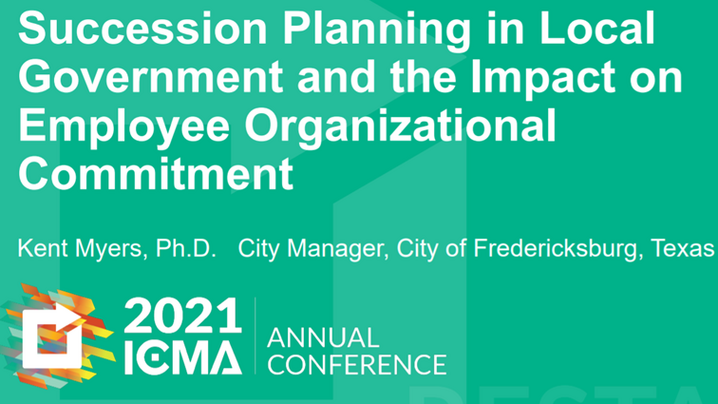
Kent Myers, city manager of Fredericksburg, Texas, presented Succession Planning in Local Government and the Impact on Employee's Organizational Commitment at the 2021 ICMA Annual Conference.
Like every industry and profession, increased number and frequency of retirements is a reality local government has already begun to face. Succession planning can help overcome this challenge with an ongoing, purposeful, and systematic identification of qualified and appropriate successors to leadership, and a commitment to developing and investing in these future leaders in order to enhance performance.
Benefits
Myers explained that beyond filling critical positions, there are many positives from having a concrete succession plan and communicating this with the entire organization:
- Supports the sustainability of the organization by ensuring future staffing needs are addressed.
- Sends a positive message to employees.
- Provides better human resource decisions in terms of selection and promotions.
- Supports ongoing training and personal growth of employees.
- Reduces hiring and relocation costs.
- Improves employee morale and productivity.
- Prepares for the future with a proactive approach rather than reactive approach.
- Enhances employee commitment to the organization.
Three Steps to Implement a Local Government Succession Plan
Myers walked through how to collect, organize, and act on information to develop the plan.
Step One: Needs Assessment
- Employees interviewed on future plans and expected retirement dates.
- Staffing needs completed to determine new positions needed to serve increasing population, increasing demand for services, and new programs and services.
- Listing of key skills, training, and experience needed to fill each position with a focus on management/leadership positions.
- Updated job descriptions completed to reflect these changing needs.
Step Two: Identification of Future Leaders
- Assessment of current employees to determine their interest, desire, and qualifications for future promotional opportunities.
- Assessment questions like: How long do you plan to work for the local government? Do you have the passion and share the long-range vision of the organization? Are you currently identified as a leader in your crew or team? Are you contented with your current position or do you aspire for promotional opportunities?
- Recognized that local government was a small organization and could not fill all future leadership positions from within the organization.
- Ensured that the process did not entitle employees for future promotions.
Step 3: Training and Education
- Established training program conducted by the local government manager.
- Presented information on leadership models and leadership styles, emotional intelligence, ethics, budgeting, and human resources.
- Encouraged employees to establish their definition of leadership and identify leaders who they admire and aspire to follow.
- Encouraged employees to obtain additional external training as needed.
By putting a real succession plan in place, local government leaders will better prepare their organization for a wave of retirements by identifying and training future leaders today.
New, Reduced Membership Dues
A new, reduced dues rate is available for CAOs/ACAOs, along with additional discounts for those in smaller communities, has been implemented. Learn more and be sure to join or renew today!
